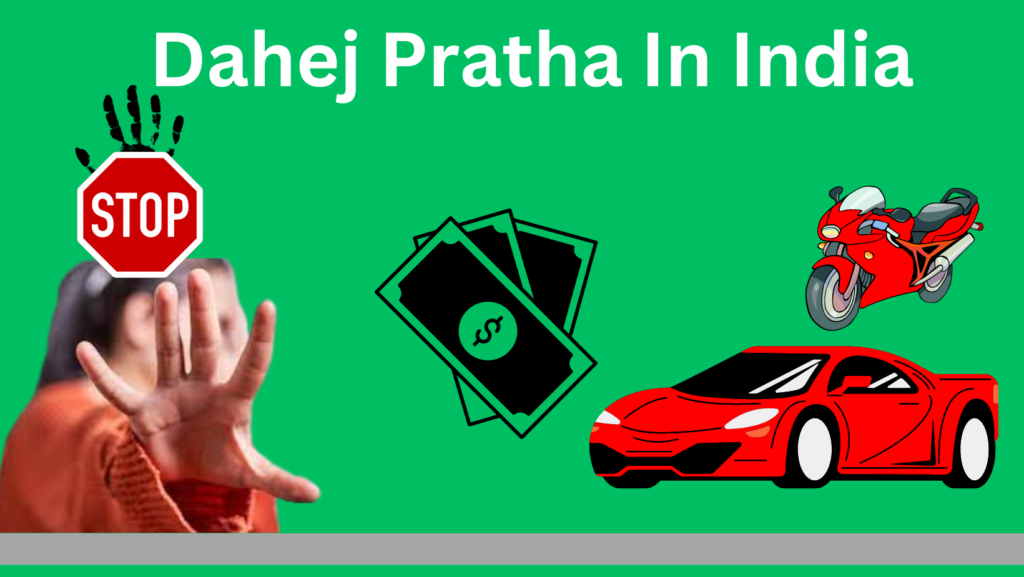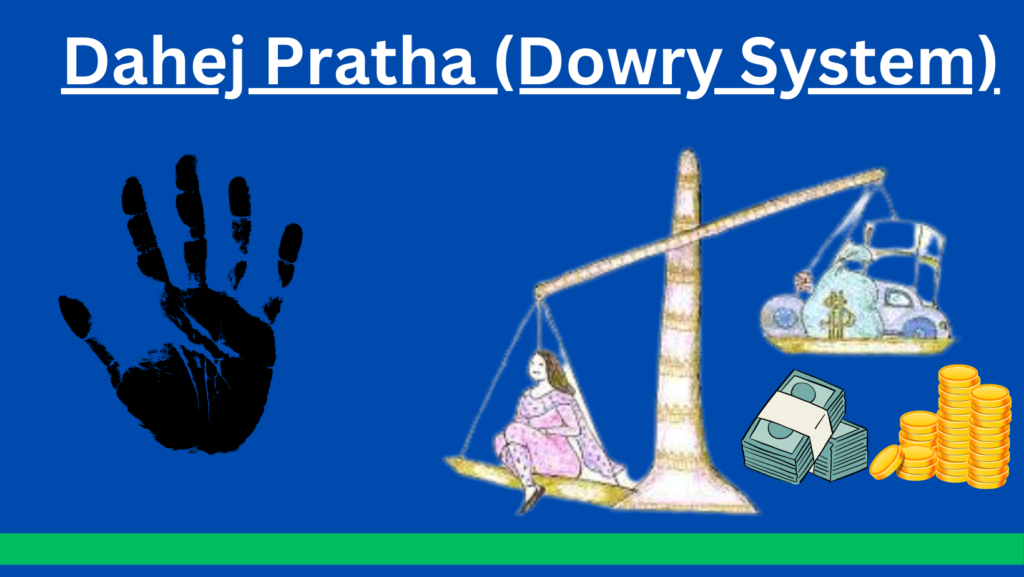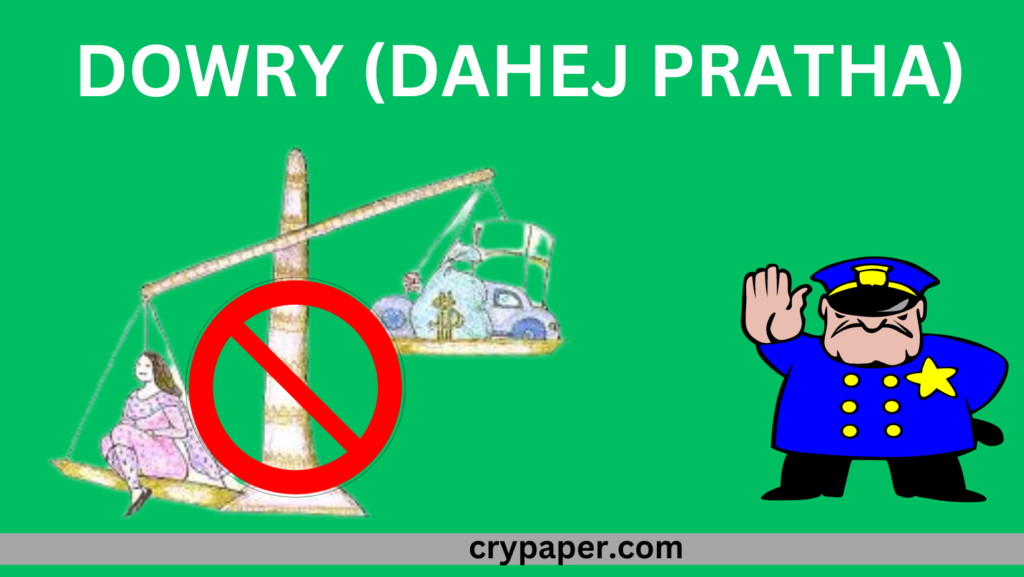Interduction To Dahej Pratha (Dowry System)
दहेज व्यवस्था क्या है ?
Dahej Pratha(Dowry ), is a social evil that has been prevalent in India for centuries. It is a practice where the bride's family is expected to pay a certain amount of money or property to the groom's family as a precondition for marriage.

This custom is considered a societal obligation and is considered a symbol of a family's wealth and status. However, it has now become a source of violence against women and a significant social issue in India. Here we also prepared an essay for dahej pratha par nibandh in hindi.
The History of Dahej Pratha (Dowry )
Dahej is not a new phenomenon in India. Its origin can be traced back to the medieval period when the system was used as a way to maintain social status and wealth. It was seen as a way to strengthen the relationship between two families and promote matrimonial alliances. However, over time, the practice has taken a turn for the worse and is now seen as a social evil.
Dahej Pratha (Dowry ) in India Today
Despite India's rapid modernization, Dahej Pratha remains a significant issue. It continues to exist in both urban and rural areas and among all castes and religions. The practice has become so ingrained in society that it is now seen as a necessary part of marriage. Dahej Pratha has caused many problems in Indian society, including domestic violence, female infanticide, and even the murder of brides.
The Effects of Dahej Pratha (Dowry ) on Women
Dowry has a devastating impact on women. It is a major reason for domestic violence against women in India. Brides who do not bring enough dowry are often subjected to physical, emotional, and mental abuse. They are often treated as second-class citizens and are expected to serve their in-laws and husbands without complaint. The situation is made worse by the fact that women in India have little legal recourse in cases of abuse.
The Causes of Dahej (Dowry )
Dahej Pratha is a complex issue with many causes. It is rooted in the belief that a woman is a burden on her family and must be married off as soon as possible. It is also linked to India's patriarchal society, where men are seen as superior to women and have the right to control their lives. Additionally, it is perpetuated by the desire for wealth and social status.
The Government's Efforts to Stop Dahej Pratha (Dowry )
The Indian government has taken several measures to stop Dowry. The Dowry Prohibition Act of 1961 was enacted to prevent the giving and receiving of dowry. It made the practice illegal and punishable by law. The government has also launched several campaigns to create awareness about the evils of Dahej Pratha. However, despite these efforts, the practice continues to exist in Indian society.
The Role of Education To Stop Dowry In India
Education is the key to stopping Dahej Pratha in India. It is the only way to change the mindset of people and create a society where women are respected and treated as equals. Education should be focused on the youth, especially girls, who should be taught to value themselves and their abilities. Parents should also be educated about the evils of Dahej Pratha and how it can harm their daughters.
Essay for Dahej Pratha (Dowry System) For Students : dahej pratha par nibandh
Dahej Pratha (Dowry System) in India:

Introduction
Dahej or Dowry is a social evil that has plagued India for decades. It is a practice where the bride's family is expected to give cash, jewelry, or other gifts to the groom's family at the time of the wedding. The dowry system has been responsible for many cases of violence against women, including domestic violence, harassment, and even murder. In this essay, we will discuss the problems caused by the dowry system in India, the solutions to this problem, government action, social awareness, laws, and acts.And this Article is for students who want to write an essay or dahej pratha par nibandh in hindi or english.
Problems Caused by the Dowry System
The dowry system in India has caused many problems, including the following:
- Gender Discrimination: The dowry system is a form of gender discrimination. Women are considered a burden on their families and are seen as inferior to men. This mindset leads to the devaluation of women and their rights.
- Domestic Violence: The dowry system has been responsible for an increase in cases of domestic violence against women. Women are subjected to physical and emotional abuse by their husbands and in-laws if they do not meet their expectations of dowry.
- Financial Burden: The dowry system puts a financial burden on the bride's family. The family is expected to provide a substantial amount of cash, jewelry, and other gifts to the groom's family. This puts a strain on the family's finances and often leads to debt and poverty.
- Health Issues: The dowry system has led to an increase in the number of cases of women being burnt or killed by their husbands or in-laws. This practice is known as "dowry death" and is a serious health issue in India.
Solutions to the Dowry System (Dahej )
The dowry system is a complex problem that requires a multi-faceted solution. Here are some possible solutions to this problem:
- Education: Education is the key to eradicating the dowry system in India. Educating women and girls about their rights and empowering them will go a long way in reducing the prevalence of the dowry system.
- Social Awareness: Social awareness campaigns can be launched to raise awareness about the ill effects of the dowry system. These campaigns can be organized in schools, colleges, and community centers.
- Legal Action: The government can take legal action against those who demand dowry. The Dowry Prohibition Act of 1961 prohibits the giving and receiving of dowry in India. Those who violate this law can be punished with imprisonment and a fine.
- Change in Mindset: A change in mindset is essential to eradicate the dowry system in India. Men and women must be educated about gender equality and the importance of treating women with respect.
Students Responsibilities about Dahej Pratha
Students have a crucial role in fighting against the Dahej (Dowry ). They can start by educating themselves about the harms and consequences of the practice. Schools and colleges can conduct awareness programs to sensitize students about the issue and its impact on society.
Students can also participate in social campaigns and activities to raise awareness and encourage people to say no to dowry . They can organize rallies, street plays, and other activities to spread awareness and educate people about their rights and the laws against dowry system.
Moreover, students can support and encourage victims of dowry by providing emotional and financial support. They can also help in providing legal assistance to those who cannot afford it.
Social Awareness Program For Dahej Pratha (Dowry )
Social awareness programs about Dowry are an essential tool to fight against this social evil. These programs aim to educate people about the consequences of dowry and raise awareness about the negative impact it has on society.
One effective way of conducting social awareness programs is through street plays, skits, and drama performances. These performances can showcase the negative impact of dowry on society and how it affects the lives of the bride and her family.
Another way to conduct social awareness programs is through seminars and workshops. Experts and activists can come together to share their experiences and knowledge about the issue. These workshops can provide a platform for discussions, debates, and sharing ideas on how to eradicate dowry from society.
Schools and colleges can also organize awareness programs to educate students about the issue. This can help in sensitizing the younger generation and instilling in them the values of equality and respect for women.Even students are promoting this solution through writing essay like dahej pratha par nibandh,dahej pratha nibandh in hindi,dahej pratha essay in hindi, dowry system essays from their side.
Apart from this, social media can also play a crucial role in spreading awareness about this Pratha (Dowry ). Social media platforms like Facebook, Twitter, and Instagram can be used to share articles, videos, and other content related to the issue.
Dahej Pratha Act(Dowry ) Act Dhara Laws In India

In India, several laws and acts have been enacted to eradicate the practice of Dahej Pratha or the dowry . The most significant among these laws are the Dowry Prohibition Act of 1961 and the Dowry Prohibition (Maintenance of Lists of Presents to the Bride and Bridegroom) Rules of 1985.
The Dowry Prohibition Act of 1961 prohibits the giving and receiving of dowry. According to the act, taking or giving dowry is a punishable offense, and the person found guilty of the offense can be sentenced to imprisonment for up to 5 years and fined up to Rs. 15,000. The act also makes it illegal to demand dowry, whether before or after marriage.
The Dowry Prohibition (Maintenance of Lists of Presents to the Bride and Bridegroom) Rules of 1985 requires the bride's family to provide a list of all the gifts given to the groom and his family at the time of marriage. This list should be signed by both the bride's and groom's families and submitted to the appropriate authorities. This rule ensures that any demands for dowry can be tracked and punished.
Apart from these laws, several amendments have been made to the Indian Penal Code to include harsher punishment for dowry-related offenses. These amendments include Section 498A, which deals with cruelty to a married woman, and Section 304B, which deals with dowry deaths.
Despite the existence of these laws, the practice of Dahej Pratha (Dowry ) continues to be prevalent in many parts of India. The lack of proper implementation of these laws, coupled with social and cultural beliefs, has made it challenging to eradicate the practice entirely.
Dahej Pratha (Dowry ) Cases In India
Dahej , also known as dowry system, has been a persistent social issue in India for decades. Despite the legal measures and social awareness programs, this practice still exists in many parts of the country, leading to various cases of exploitation and violence against women. In this article, we will discuss some of the prominent Dowry cases in India.
- The Rohtak Sisters Case: In 2014, two sisters from Rohtak, Haryana, were reportedly seen beating up three men who were allegedly harassing them on a bus. The video of the incident went viral on social media and the sisters were hailed as heroes. However, a few days later, it was revealed that the sisters' family had been demanding dowry from the men and they had attacked them when they refused to pay. This incident brought to light the ugly reality of how even educated families can be involved in such practices.
- Nisha Sharma Case: Nisha Sharma, a young woman from Delhi, made headlines in 2003 when she called off her wedding after her fiancé's family demanded a dowry of Rs. 1 crore. She filed a case against her fiancé and his family and became a symbol of resistance against the dowry system. Her case led to the formation of the Dowry Prohibition Act, 1961, which criminalizes the act of giving or receiving dowry.
- Kausar Jahan Case: Kausar Jahan was a 19-year-old girl from West Bengal who was burnt alive by her in-laws in 2016 because her family was unable to meet their demands for dowry. Her father had sold his land and borrowed money to pay the dowry, but the in-laws were still not satisfied. This tragic incident highlights the extreme consequences of the dowry system.
- Anuradha Saha Case: Anuradha Saha was a young doctor from Kolkata who died in 1998 due to medical negligence. Her husband, who was also a doctor, had demanded a huge dowry from her family before the marriage. When they refused to pay, he sabotaged her medical treatment, leading to her death. This case led to the passing of the Consumer Protection Act, which allows victims of medical negligence to seek compensation.
- Priyanka Singh Case: Priyanka Singh, a 21-year-old girl from Uttar Pradesh, was set on fire by her husband and in-laws in 2013 because her family could not pay the dowry. She suffered 80% burns and eventually died in the hospital. Her case highlights the need for stricter implementation of anti-dowry laws and the urgent need for social awareness programs to eradicate this practice.
These are just a few of the many cases that have come to light in recent years. While legal measures and social awareness programs have helped in curbing this practice to some extent, there is still a long way to go in eradicating it completely. The need of the hour is to create a culture of respect and equality for women and to empower them to stand up against any form of exploitation and violence.
Who Started Dahej (Dowry ) in India ?
It is not clear who exactly started the practice of Dahej Pratha (dowry system) in India as it is believed to have been prevalent in some form or the other since ancient times. However, over the years, it has become more institutionalized and has taken on a more sinister form, with the demand for dowry often leading to harassment, violence, and even death of women. It is important to note that the practice of dowry is illegal in India and those found guilty of taking or giving dowry can face imprisonment and hefty fines.
Government Action Dahej Pratha act in India
The Indian government has taken several measures to eradicate the dowry system in India. Here are some of the government's actions:
- Dowry Prohibition Act: The Dowry Prohibition Act of 1961 prohibits the giving and receiving of dowry in India. Those who violate this law can be punished with imprisonment and a fine.
- National Commission for Women: The National Commission for Women was set up in 1992 to protect and promote the rights of women in India. The commission has taken several measures to combat the dowry system in India.
- Beti Bachao, Beti Padhao: The Beti Bachao, Beti Padhao (Save the Daughter, Educate the Daughter) campaign was launched by the Indian government in 2015 to promote
- The Indian government has taken various steps to combat the menace of dowry. The Dowry Prohibition Act was enacted in 1961, which makes the practice of dowry illegal. It is a criminal offense to give or receive dowry. The law also provides for imprisonment and a fine for those who violate the act. The Protection of Women from Domestic Violence Act, 2005, provides additional protection to women from violence and harassment. The act recognizes dowry harassment as a form of domestic violence and provides for stringent punishment for the offenders.
- The government has also launched various schemes and programs to promote gender equality and women's empowerment. These include the Beti Bachao Beti Padhao Yojana, which aims to improve the status of the girl child and promote her education. The government has also started the Mahila E-Haat initiative to promote entrepreneurship among women.
- Laws and Acts
- Apart from the Dowry Prohibition Act and the Protection of Women from Domestic Violence Act, several other laws and acts have been enacted to protect women's rights in India. The Hindu Marriage Act, 1955, provides for the right to maintenance and residence for the wife after marriage. The Criminal Law (Amendment) Act, 2013, was enacted after the Nirbhaya case to provide for stringent punishment for offenses against women, including rape and acid attacks.
- However, despite the existence of these laws, the implementation and enforcement have been weak. Many cases of dowry harassment and violence against women go unreported, and the offenders often go unpunished.
Conclusion
Dowry (Dahej) is a social evil that has plagued Indian society for centuries. It has caused immense suffering and has denied women their right to live with dignity and respect. While there have been significant efforts to eradicate the practice, much more needs to be done. Social awareness campaigns, education, and economic empowerment can go a long way in changing people's mindset and reducing the incidence of dowry. At the same time, the government needs to ensure the proper implementation of laws and acts and provide support to women who are victims of dowry harassment and violence.
It is time for society as a whole to come together to fight this evil and create a more equal and just society where women can live without fear of violence and discrimination.
[sp_easyaccordion id="1606"]
Thank you for reading this essay on Dahej Pratha, Dowry System of India.


